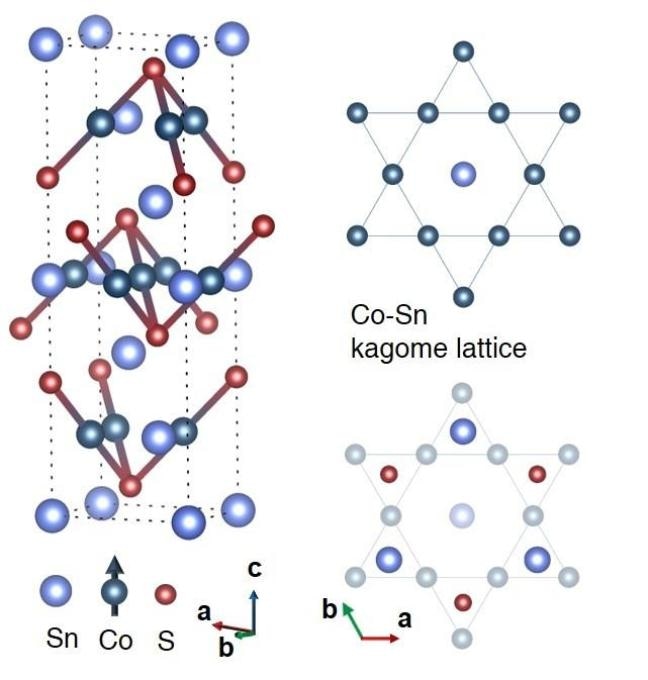Feb 25 2019
Borrowing their name from a complex Japanese basket pattern, kagome magnets are said to possess electronic properties that could be beneficial for forthcoming quantum devices and applications. Theories forecast that some electrons in these materials have unusual, so-called topological behaviors and others act slightly like graphene, another material valued for its potential for new kinds of electronics.
 Researchers explored a material that has an internal structure, shown in 3D in left panel, that consists of triangles and hexagons arranged in a pattern similar to that of a Japanese kagome basket. (Image credit: Hasan, et. al, Princeton University)
Researchers explored a material that has an internal structure, shown in 3D in left panel, that consists of triangles and hexagons arranged in a pattern similar to that of a Japanese kagome basket. (Image credit: Hasan, et. al, Princeton University)
Presently, an international team of researchers led by Princeton University scientists have noticed that some of the electrons in these magnets act collectively, like a virtually infinitely massive electron that is oddly magnetic, rather than like separate particles. The research was reported in the journal Nature Physics recently.
The team also demonstrated that positioning the kagome magnet in a high magnetic field results in the reversal of the direction of magnetism. This “negative magnetism” is similar to having a compass that points south rather than the north, or a refrigerator magnet that unexpectedly refuses to stick.
“We have been searching for super-massive 'flat-band' electrons that can still conduct electricity for a long time, and finally we have found them,” said M. Zahid Hasan, the Eugene Higgins Professor of Physics at Princeton University, who guided the team. “In this system, we also found that due to an internal quantum phase effect, some electrons line up opposite to the magnetic field, producing negative magnetism.”
The team investigated how atoms organized in a kagome pattern in a crystal emanate odd electronic properties that can have real-world advantages, such as superconductivity, which enables electricity to flow without loss as heat, or magnetism that can be manipulated at the quantum level for use in up and coming electronics.
The scientists used advanced scanning tunneling microscopy and spectroscopy (STM/S) to study at the behavior of electrons in a kagome-patterned crystal composed of tin and cobalt, sandwiched between two layers of sulfur atoms, which are additionally sandwiched between two layers of tin.
In the kagome layer, the cobalt atoms create triangles around a hexagon with a tin atom in the center. This geometry pushes the electrons into some tight positions—resulting in this type of material to be referred to as a “frustrated magnet.”
To investigate the electron behavior in this structure, the scientists nicked the top layers to expose the kagome layer underneath.
They then used the STM/S method to sense each electron’s energy profile, or band structure. The band structure defines the range of energies an electron can possess inside a crystal, and explains, for instance, why certain materials convey electricity and others are insulators. The scientists learned that a few of the electrons in the kagome layer have a band structure that, instead of being curved as in a majority of materials, is flat.
A flat band structure specifies that the electrons have a real mass that is very large so to be nearly infinite. In such a state, the particles behave collectively instead of as individual particles.
Theories have for some time projected that the kagome pattern would form a flat band structure, but this study is the first experimental discovery of a flat band electron in such a system.
One of the general estimates that ensues is that a material with a flat band may display negative magnetism.
Actually, in the present research, when the scientists applied a robust magnetic field, some of the electrons in the kagome magnet pointed in the opposite direction.
“Whether the field was applied up or down, the electrons’ energy flipped in the same direction, that was the first thing that was strange in terms of the experiments,” said Songtian Sonia Zhang, a graduate student in physics and one of three co-first-authors on the paper.
“That puzzled us for about three months,” said Jia-Xin Yin, a postdoctoral research associate and another co-first author on the research. “We were searching for the reason, and with our collaborators we realized that this was the first experimental evidence that this flat band peak in the kagome lattice has a negative magnetic moment.”
The scientists learned that the negative magnetism develops because of the relationship between the kagome flat band, a quantum occurrence called spin-orbit coupling, magnetism and a quantum factor known as the Berry curvature field. Spin-orbit coupling denotes a situation where an electron’s spin, which itself is a quantum feature of electrons, becomes connected to the electron’s orbital rotation. The mixture of spin-orbital coupling and the material’s magnetic nature leads all the electrons to act in lock step, like a massive single particle.
Another fascinating behavior that develops from the firmly coupled spin-orbit interactions is the development of topological behaviors. The topic of the 2016 Nobel Prize in Physics, topological materials can contain electrons that flow without resistance on their surfaces and are a vibrant area of study. The cobalt-tin-sulfur material is an instance of a topological system.
Two-dimensional patterned lattices can comprise of other appropriate types of electron conductance. For instance, graphene is a pattern of carbon atoms that has produced substantial interest for its electronic applications over the past twenty years. The kagome lattice’s band structure forms electrons that act in the same way to those in graphene.
Funding for this research was offered by the Gordon and Betty Moore Foundation, the United States Department of Energy under the Basic Energy Sciences program, the Princeton Center for Theoretical Science and the Princeton Institute for the Science and Technology of Materials Imaging and Analysis Center at Princeton University, Lawrence Berkeley National Laboratory, and the University of California, Berkeley.